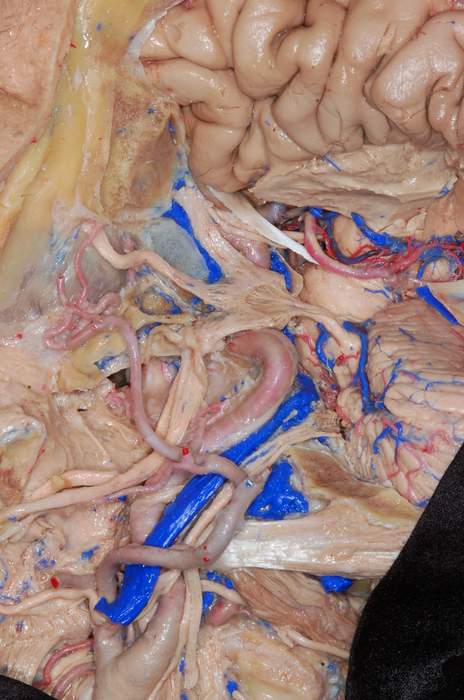Left Lateral View of Frontal Lobe, Middle and Posterior Fossa Floors, Brainstem, Cerebellum, Infratemporal Fossa, and Deep Neck
7451

Surgical Correlation
Tags
Left lateral view of frontal lobe, middle and posterior fossa floors, brainstem, cerebellum, infratemporal fossa, and deep neck. Extensive removal of skull bone has exposed the floors of the middle and posterior fossae. The inferior frontal gyrus, represented by the pars orbitalis, triangularis, and opercularis, is separated from the temporal lobe (removed) by the lateral or Sylvian sulcus. The precentral gyrus or primary motor cortex is the posterior portion of the frontal lobe. It is separated from the postcentral gyrus or primary somatosensory cortex of the parietal lobe by the central sulcus. The inferior portion of the postcentral gyrus merges with the supramarginal gyrus, a component of the multimodal somatosensory association cortex contributed also by the angular gyrus located immediately posterior to it. Together, they compose the inferior parietal lobule. The trigeminal nerve is shown emerging from the pons and its ganglion, resting on the trigeminal impression of the petrous apex. It gives rise to the ophthalmic, maxillary, and mandibular divisions. Posteriorly, in the posterior fossa, the anterior and posterior lobes of the cerebellum can be seen behind the pons and are separated by the primary fissure of the cerebellum. A portion of the tentorium cerebelli remains attached to the clinoid processes of the sphenoid bone where the cavernous segment of the internal carotid artery can be seen within the cavernous sinus. Traversing the lateral wall of this sinus are the oculomotor, trochlear, and ophthalmic nerves enroute to the orbit. The trochlear nerve emerges from the dorsal surface of the midbrain before passing forward and is the only cranial nerve with a dorsal origin. The P2 segment of the posterior cerebral artery, a terminal branch of the basilar artery, is shown coursing around the midbrain before continuing as the P3 segment in the quadrigeminal cistern. The posterior cerebral arteries supply the occipital lobes and posteromedial temporal lobes. The superior petrosal vein is also in view. It drains the anterior and lateral surfaces of the brainstem and parts of suboccipital and tentorial surfaces of the brain and empties into the superior petrosal sinus. In the infratemporal fossa the lateral pterygoid muscle has been removed. The maxillary artery, one of the terminal branches of the external carotid artery, traverses the infratemporal fossa giving rise to several branches, such as those shown here: inferior alveolar, middle meningeal, posterior superior alveolar, and infraorbital arteries. The sphenopalatine artery continues through the pterygomaxillary fissure into the pterygopalatine fossa where the maxillary nerve is also seen. The buccal and auriculotemporal branches of the mandibular nerve are in view. The inferior alveolar and lingual nerves descend on the surface of the medial pterygoid muscle to the mandibular canal and floor of the mouth, respectively. In the lateral neck, the common carotid artery divides into its external and internal carotid branches. The cervical segment of the ICA continues as the petrous segment once it enters the carotid canal. The internal jugular vein emerges from the nearby jugular foramen and descends in the neck. The hypoglossal nerve emerges between the IJV and proximal part of the ECA and courses forward superficial to the hyoglossus muscle. It then passes deep to the mylohyoid muscle to supply motor innervation to the intrinsic and extrinsic muscles of the tongue, except palatoglossus. The superior thyroid and occipital arteries arise, respectively, from the anterior and posterior borders of the external carotid artery. The superior laryngeal artery, a branch of the superior thyroid, courses with the internal laryngeal nerve toward and through the thyrohyoid membrane to supply part of the interior of the larynx. The superior root of the ansa cervicalis (containing C1 nerve fibers) leaves the epineurial sheath of the hypoglossal and descends in the neck where it unites with the inferior root to supply motor innervation to most of the infrahyoid muscles. The ECA terminates as the superficial temporal and maxillary arteries near the neck of the mandible. Deep neck musculature has been removed to show portions of the suboccipital muscles: obliquus capitis inferior and superior, which have common attachments to the transverse process of the atlas vertebra. Part of the vertebral artery is exposed prior to entering the transverse foramen of the atlas. It is crossed superficially by the ventral ramus of the C2 spinal nerve. The greater occipital nerve, the dorsal ramus of C2, is shown emerging from the lower border of the obliquus capitis inferior muscle and provides sensory innervation to most of the posterior scalp. The proximal portions of the anterior and middle scalene muscles are also visible. (Image courtesy of PA Rubino)



